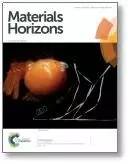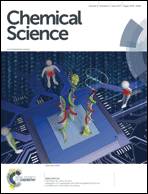材料领域近期热点文章
材料类综合、全面、专业的微信平台
Material Horizon 和 Chemical Science 主编推荐近期发表的材料领域的热点文章:
Material Horizon (IF: 10.706)
Programming 2D/3D shape-shifting with hobbyist 3D printers
Teunis van Manen, Shahram Janbaz and Amir A. Zadpoor*
Mater. Horiz., 2017, Advance Article.
DOI: 10.1039/C7MH00269F
Abstract:
形状转换材料可以将复杂的3D形状与可精确调控的表面功能(如生物纳米图案和印刷电子器件)结合起来,得到研究工作者的高度关注。来自荷兰代尔夫特理工大学的Zadpoor教授及其团队发展了一种新颖的形状转换技术,只需要一台非专业的3D打印机和廉价现成的材料便可实现。
Materials and devices with advanced functionalities often need to combine complex 3D shapes with functionality-inducing surface features. Precisely controlled bio-nanopatterns, printed electronic components, and sensors/actuators are all examples of such surface features. However, the vast majority of the refined technologies that are currently available for creating functional surface features work only on flat surfaces. Here we present initially flat constructs that upon triggering by high temperatures change their shape to a pre-programmed 3D shape, thereby enabling the combination of surface-related functionalities with complex 3D shapes. A number of shape-shifting materials have been proposed during the last few years based on various types of advanced technologies. The proposed techniques often require multiple fabrication steps and special materials, while being limited in terms of the 3D shapes they could achieve. The approach presented here is a single-step printing process that requires only a hobbyist 3D printer and inexpensive off-the-shelf materials. It also lends itself to a host of design strategies based on self-folding origami, instability-driven pop-up, and ‘sequential’ shape-shifting to unprecedentedly expand the space of achievable 3D shapes. This combination of simplicity and versatility is a key to widespread applications.
A temperature and electric field-responsive flexible smart film with full broadband optical modulation
Xiao Liang, Shumeng Guo, Mei Chen, Chenyue Li, Qian Wang, Cheng Zou, Cuihong Zhang, Lanying Zhang, Shaojun Guo* and Huai Yang*
Mater. Horiz., 2017, Advance Article.
DOI: 10.1039/C7MH00224F
Abstract:
这篇论文报道了用于节能智能窗户的多功能光学材料制备的关键进展。来自北京大学的研究人员展示了一种具有迄今报道的最广谱调节波段的柔性多响应智能膜材料。
This study provides a new procedure for the preparation of a flexible multi-responsive smart film containing tin-doped indium oxide nanocrystals and a phase-separated liquid crystal-polymer. This film can reversibly control the passage of visible light in response to temperature and electric field and also screen near infrared light.
Chemical Science (IF: 8.668)
Catechol adsorption on graphene nanoplatelets: isotherm, flat to vertical phase transition and desorption kinetics
Lifu Chen, Xiuting Li, Eden E. L. Tanner and Richard G. Compton*
Chem. Sci., 2017, 8, 4771-4778
DOI: 10.1039/C7SC01331K
Abstract:
牛津大学的研究人员在这篇论文中展示了一种研究儿茶酚在石墨烯纳米片上吸附和解吸的新策略。相关的电化学和光谱研究发现,在低浓度下吸附行为符合Langmuir方程,而在高浓度下发生水平到垂直的相变。解吸动力学研究表明这是一个一级过程。这种方法有望用于表征纳米材料上的一系列分子。
The adsorption of catechol (1,2-dihydroxybenzene) on graphene nanoplatelets (GNPs) is investigated electrochemically and spectroscopically. The reversible adsorption of catechol on GNPs is Langmuirian with an adsorption constant of (0.2 ± 0.002) mM-1 at low adsorbate concentrations (≤100 mM). At higher concentrations (>100 mM) the adsorption of catechol on GNPs is shown to undergo a flat to vertical concentration driven phase transition. The kinetics of desorption are measured with a single particle electrochemical technique. The study of individual impacts allows the determination of the rate of catechol desorption from GNPs to be k = 0.08 ± 0.01 s-1 with first order kinetics. The method provides a powerful and efficient generic approach to study adsorption and, importantly, desorption of molecules on nanomaterials, as well as giving insight into the modification process.
Is iron unique in promoting electrical conductivity in MOFs?
Lei Sun, Christopher H. Hendon, Sarah S. Park, Yuri Tulchinsky, Ruomeng Wan, Fang Wang, Aron Walsh and Mircea Dincă*
Chem. Sci., 2017, 8, 4450-4457
DOI: 10.1039/C7SC00647K
Abstract:
美国、英国和韩国的科学家对优化金属-有机框架(MOF)中的电荷传输和电荷密度的金属离子进行研究,从而提高材料的导电性。他们测试了20种MOF的电导率和活化能,发现铁基MOF具有最好的电学性质,原因在于Fe2+ 具有高能价电子和 Fe2+/3+混合价。该研究可用于提高这些多孔材料的电导率。
Identifying the metal ions that optimize charge transport and charge density in metal–organic frameworks is critical for systematic improvements in the electrical conductivity in these materials. In this work, we measure the electrical conductivity and activation energy for twenty different MOFs pertaining to four distinct structural families: M₂(DOBDC)(DMF)₂ (M =Mg2+, Mn2+,Fe2+, Co2+, Mi2+,Cu2+,Zn2+); H4DOBDC = 2,5-dihydroxybenzene-1,4-dicarboxylic acid; DMF = N,N-dimethylformamide), M₂(DSBDC)(DMF)₂ (M = Mn2+, Fe2+; H4DSBDC = 2,5-disulfhydrylbenzene-1,4-dicarboxylic acid), M₂Cl₂(BTDD)(DMF)₂ (M =Mn2+, Fe2, Co2+, Ni2+; H₂BTDD = bis(1H-1,2,3-triazolo[4,5-b],[4′,5′-i]dibenzo[1,4]dioxin), and M(1,2,3-triazolate)₂ (M = Mg2+, Mn2+, Fe2+, Co2+, Cu2+, Zn2+, Cd2+). This comprehensive study allows us to single-out iron as the metal ion that leads to the best electrical properties. The iron-based MOFs exhibit at least five orders of magnitude higher electrical conductivity and significantly smaller charge activation energies across all different MOF families studied here and stand out materials made from all other metal ions considered here. We attribute the unique electrical properties of iron-based MOFs to the high-energy valence electrons of Fe2+ and the Fe2+/3+ mixed valency. These results reveal that incorporating Fe2+ in the charge transport pathways of MOFs and introducing mixed valency are valuable strategies for improving electrical conductivity in this important class of porous materials.
— END —
相关阅读:
来源:RSCPublishing。编辑:明轩
*本文系转载,如有问题请联系我们以便处理













